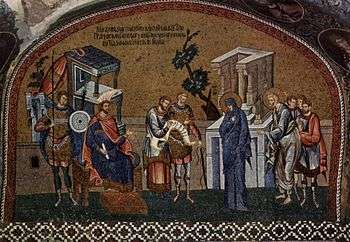Census of Quirinius
| Part of a series on |
 |
|
The Census of Quirinius was a census of Judea taken by Publius Sulpicius Quirinius, Roman governor of Syria, upon the imposition of direct Roman rule in 6 CE.[1] The author of the Gospel of Luke uses it as the narrative means to establish the birth of Jesus (Luke 2:1–5),[2] but Luke places the census within the reign of Herod the Great, who died 10 years earlier[3] in 4 BCE.[4] No satisfactory explanation of the contradiction seems possible on the basis of present knowledge,[5] and most scholars think that the author of the gospel made a mistake.[6]
The census
In 6 CE Publius Sulpicius Quirinius was appointed Imperial Legate (governor) of the province of Roman Syria and tasked to carry out a tax census of the new province of Judea, one of the three territories into which the kingdom of Herod the Great had been divided on his death in 4 BCE.[7] The Gospel of Luke links the birth of Jesus under the reign of Caesar Augustus ("In the days of Caesar Augustus..."–
Luke 2:1) to the census:
In those days a decree went out from Emperor Augustus that all the world should be registered. This was the first registration and was taken while Quirinius was governor of Syria. All went to their own towns to be registered. Joseph also went from the town of Nazareth in Galilee to Judea, to the city of David called Bethlehem, because he was descended from the house and family of David. He went to be registered with Mary, to whom he was engaged and who was expecting a child.
There are major difficulties in accepting Luke's account: the census in fact took place in 6 CE, ten years after Herod's death in 4 BCE; there was no single census of the entire empire under Augustus; no Roman census required people to travel from their own homes to those of distant ancestors; and the census of Judea would not have affected Joseph and his family, living in Galilee.[6] Some conservative scholars have argued that Quirinius may have had an earlier and historically unattested term as governor of Syria, or that he previously held other senior positions which may have led him to be involved in the affairs of Judea during Herod's reign, or that the passage should be interpreted in some other fashion.[8][9][10] These arguments have been rejected by mainline scholarship as "exegetical acrobatics"[11][12] and most have concluded that the author of Luke's gospel made an error.[6]
See also
References
Citations
- ↑ Gruen 1996, p. 157.
- ↑ Edwards 2015, p. 68–69.
- ↑ Sanders 1995, p. 111.
- ↑ Gruen 1996, p. 156.
- ↑ Edwards 2015, p. 71.
- 1 2 3 Brown 1978, p. 17.
- ↑ Gruen 1996, p. 156-157.
- ↑ Bruce, F.F. Jesus and Christian Origins Outside the New Testament. Grand Rapids: William B. Eerdsmans Publishing Company, 1974 pp.193-194
- ↑ Habermas, Gary R. Ancient Evidence for the Life of Jesus. Nashville: Thomas Nelson, Inc. 1984 pp.152-153
- ↑ Gregory A. Boyd and Paul Rhodes Eddy. Lord or Legend? Grand Rapids: Baker Books 2007 pp.142-143
- ↑ Novak 2001, p. 293-298.
- ↑ Vermes 2006, p. 28-30.
Bibliography
- Allert, Craig D. (2007). A High View of Scripture?. Baker Books. ISBN 9780801027789.
- Blomberg, C.E. (1995). "Quirinius". In Bromiley, Geoffrey W. The International Standard Bible Encyclopedia. 4. Eerdmans. ISBN 9780802837844.
- Brown, R.E. (1978). An Adult Christ at Christmas: Essays on the Three Biblical Christmas Stories. Liturgical Press. ISBN 9780814609972.
- Burkett, Delbert (2002). An Introduction to the New Testament and the Origins of Christianity. Cambridge University Press. ISBN 978-0-521-00720-7.
- Charlesworth, James H. (2008). The Historical Jesus: An Essential Guide. Abingdon Press. ISBN 9781426724756.
- Edwards, James R. (2015). The Gospel of Luke. Eerdmans. ISBN 9780802837356.
- Freeman, Charles (2009). A New History of Early Christianity. Yale University Press. ISBN 9780300125818.
- Green, Joel (1997). The Gospel of Luke. Eerdmans. ISBN 9780802823151.
- Gruen, Erich S. (1996). "The Expansion of the Empire Under Augustus". In Bowman, Alan K.; Champlin, Edward; Lintott, Andrew. The Cambridge Ancient History. 10. Cambridge University Press. p. 157. ISBN 9780521264303.
- Maisch, Ingrid; Vogle, Anton (1975). "Jesus Christ". In Rahner, Karl. Encyclopedia of Theology. A&C Black. ISBN 9780860120063.
- Merz, Annette (2015). "The Quest for the Historical Jesus". In Van Kooten, George H.; Barthel, Peter. The Star of Bethlehem and the Magi: Interdisciplinary Perspectives from Experts on the Ancient Near East, the Greco-Roman World, and Modern Astronomy. BRILL. ISBN 9789004308473.
- Millar, Fergus (1993). The Roman Near East, 31 B.C.-A.D. 337. Harvard University Press. ISBN 9780674778863.
- Novak, Ralph Martin (2001). Christianity and the Roman Empire: Background Texts. Continuum International. ISBN 9780567018403.
- Perkins, Pheme (2009). Introduction to the Synoptic Gospels. Eerdmans. ISBN 9780802865533.
- Sanders, E.P. (1995). The Historical Figure of Jesus. Penguin UK. ISBN 9780141928227.
- Theissen, Gerd; Merz, Annette (1998). The historical Jesus: a comprehensive guide. Eerdmans.
- Vermes, Geza (2010). Jesus: Nativity - Passion - Resurrection. Penguin UK. ISBN 9780141957449.
- Géza Vermes (2 November 2006). The Nativity: History and Legend. Penguin Books Limited. ISBN 978-0-14-191261-5.
